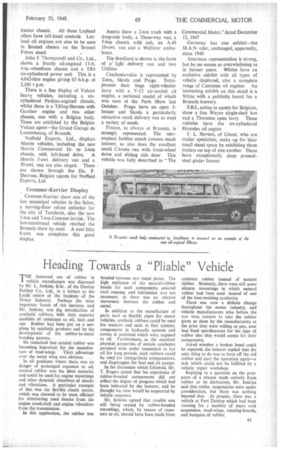Heading Towards a "Pliable" Vehicle
Page 35

If you've noticed an error in this article please click here to report it so we can fix it.
THE increased use of rubber in vehicle manufacture was discussed by Mr L. Jenkins, B.Sc., of the Dunlop Rubber Co., Ltd., in a lecture to thern Leeds centre of the Institute of the Motor Industry. Perhaps the Most important factor of this increase, said Mr. Jenkins, was the introduction of synthetic rubbers, .with their superior qualities of resistance .to, oil, heat and age. Rubber had been put on a new plane by synthetic products and by the development of the rubber-to-metal bonding process. He remarked that. natuial rubber was becoming important for the manufac ture of mud-wings. 'their advantage over the metal wing was obvious. , In all positions where there was no danger of prolonged exposure to oil, natural rubber was the ideal material, and could be used for engine mountings and other dynamic absorbers of shocks and vibrations. A particular example of this was the flexible clutch centre, which was claimed to be most efficient for eliminating road shocks from the engine crankshaft and engine vibrations from the transmission.
In this application, the rubber was
bonded between two metal plates, The high resilience of the natural-rubber bonds for such components ensured cool. running and lubrication was not . necessary, as there was no relative movement between the rubber and
• metal.
In addition to the manufacture of parts such as flexible pipes for motor vehicles, synthetic rubbers could be used for washers and seals in fuel systems, components in hydraulic systems and .covers in positions which were exposed to oil. Furthermore, as the excellent physical properties of certain synthetics • persisted even under immersion in hot oil for long periods, such rubbers could be used for timing-chain compensators, and diaphragms for fuel and oil pumps. in the discussion which followed, Mr. T. Rogers stated that his experience of rubber-bonded components did not reflect the degree of progress which had been indicated by the lecturer-, and he thought his view would be supported by vehicle repairers.
Mr. Jenkins agreed that trouble was still being caused by rubber-bonded mountings, which, by reason of exposure to oil, should have been made from
synthetic rubber instead of natural rubber. Similarly, there were still some silencer mountings in which natural rubber had been used instead of one of the heat-misting synthetics
There Was now a definite change throughout the motor industry, and vehicle manufactuters who before the war were content to take the rubber given to them by the manufacturers at the price they were willing to pay, now had fixed specificatioos for the type of rubber that they would accept for their components.
Asked whether a broken bond could be repaired, the lecturer replied that the only thing to do was to burn off the old rubber and start the operation again—a task which could not be fulfilled by a vehicle repair workshop.
Replying to a question on the prospects of a chassis made entirely from rubber or its derivatives, Mr. Jenkins said that rubbe suspensions were under consideration, but there was nothing beyond. that. At present, there was a vehicle at Fort Dunlop which had been running for a number of years with suspension, mud-wings, running-boards, and bumpers of rubber.




















































































